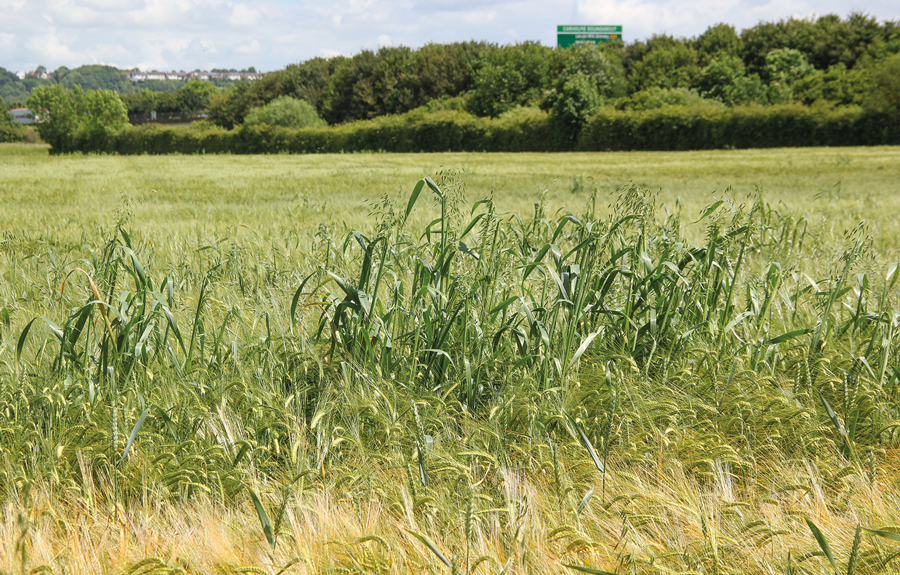Wrestling with wild oats
2nd August 2019
In the final column in our series on integrated controls to manage the ‘big five’ grass weeds, Barrie Hunt turns his attention to wild oats.
In the final column in our series on integrated controls to manage the ‘big five’ grass weeds, Barrie Hunt turns his attention to wild oats.
Increasing reliance on pre-em and peri-em herbicides in place of later post-em winter cereal applications to deal with the likes of black-grass, bromes and Italian ryegrass can easily open the door to wild oats if we are not very careful. As can spring cropping.
So it’s hardly surprising that, despite being relatively easier to control than these other annuals, wild oats are currently problematic on almost 20 per cent of the national winter cereals area. Nor that many farms find them noticeably more troublesome than either bromes or Italian rye-grass.
Wild oat infestations tend to build-up less rapidly than other grass weeds because they produce fewer seeds. This means the level of control we need to prevent populations increasing is only 75-85 per cent, compared with more than 95 per cent for black-grass.
Although resistance is widespread, many post-em herbicides can still give us good control of most emerged wild oats. The problem, however, lies in the fact that their emergence is extremely variable and can be from considerably greater depths than most other grass weeds.
So the most effective control comes from later autumn or spring applications, with pre-em herbicides often having a limited effect – in direct contrast to our best approach with black-grass, bromes or Italian ryegrass. On top of this, we have the added complication of spring as well as winter wild oat species, which often occur in the same field and are encouraged by spring cropping.
Under these circumstances, it’s essential we keep up our guard against wild oats. Not least because their highly competitive nature means a single plant/m2 can cut winter wheat yields by up to 1t/ha and spring cereals by as much as 0.6t/ha.
Test for resistance
Regardless of what we do to control other grass weeds, if we have wild oat problems beyond roguable levels, we should employ post-em applications of fops, dims, dens or ALS inhibitors like mesosulfuron + iodosulfuron and pyroxsulam mixtures. Given the problem of resistance, though, it’s advisable to have a sample of weed seeds tested to confirm the particular population’s herbicide sensitivity. That way we make the best product choice.
Chemical controls remain important with wild oats because their protracted germination pattern and ability to emerge from 10–15cm or more, means the key cultural controls of later autumn drilling, spring cropping and ploughing are generally less effective.
Even so, there is plenty we can do culturally to support in-crop control. Like meadow, rye and soft bromes, we need to delay post-harvest cultivations for as long as possible to allow freshly shed wild oat seed to germinate or lose its viability on the surface. Otherwise we can induce dormancy for up to six years.
Again this may conflict with our best approach for controlling sterile brome as well as black-grass and ryegrass. Addressing these problems with later winter cereal drilling – not to mention spring sowing – however, should give us plenty of time to set-up a good stale seedbed and spray it off with Roundup ahead of drilling even after an initial delay of four to six weeks.
Like dealing with the other problem grass weeds, minimal further soil disturbance in the run-up to, and at drilling, is also important here to minimise wild oat germination in the seedbed.
Control opportunities
Alongside the most effective combination of controls in our cereals, we should take full advantage of the excellent opportunities we have for controlling wild oats with actives like clethodim and propyzamide in our cereal breaks too.
Being highly susceptible to competition in their early growth stages, competitive crops like winter OSR and beans can be very valuable in dealing with later-emerging wild oats. Equally, late-sown spring crops like peas and linseed can help by giving us the greatest possible time for pre-planting control with Roundup.
Finally, we mustn’t forget hand-rogueing or patch-spraying in June wherever we’ve contained the problem sufficiently. These will almost certainly be justified by the extent to which we limit seed return as well as yield impact. They are especially important, of course, wherever herbicide resistance has been confirmed or suspected.
As Roundup technical manager, Barrie Hunt co-ordinates the national on-line resource (www.monsanto-ag.co.uk/grassweed-action) providing the best information and guidance for growers keen to control grass weeds in the most sustainable way possible.

